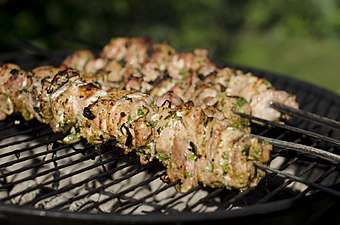Shashlik
 Shashlik cooked outdoors | |
| Course | Main course |
|---|---|
| Place of origin | Caucasus, Central Asia[1] |
| Serving temperature | Hot |
| Main ingredients | Meat, marinade, onions |
Shashlik or shashlyk is a dish of skewered and grilled cubes of meat, similar to or synonymous with shish kebab. It is known by this name traditionally in the Caucasus and Central Asia, and from the 19th century became popular across much of the Russian Empire.[1][2][3]
Etymology and history
The word "shish" means skewer. The word "shishlik" is literally translated from Turkic languages as "skewerable". Even though the word "shashlyk" was borrowed from the Crimean Tatars by the Cossacks as early as the 16th century,[4] shashlik did not reach Moscow until the late 19th century.[5] From then on, their popularity spread rapidly; by the 1910s they were a staple in St Petersburg restaurants and by the 1920s they were already a pervasive street food all over urban Russia.
Preparation

Shashlik was originally made of lamb. Nowadays it is also made of pork or beef depending on local preferences and religious observances. The skewers are either threaded with meat only, or with alternating pieces of meat, fat, and vegetables, such as bell pepper, onion, mushroom and tomato. In Iranian cuisine, meat for shashlik (as opposed to other forms of shish kebab) is usually in form of large chunks of meat,[6][7] while elsewhere the form of medium-size meat cubes is maintained making it similar to brochette. The meat is marinated overnight in a high-acidity marinade like vinegar, dry wine or sour fruit/vegetable juice with the addition of onions, herbs and spices.[8]
While it is not unusual to see shashlik today listed on the menu of restaurants, it is more commonly sold in the form of fast-food by street vendors who roast the skewers over wood, charcoal, or coal. It is also cooked in outdoor environments during social gatherings, similarly to barbecue in English-speaking countries.
See also
References
- 1 2 Kraig, Bruce; Taylor Sen, Colleen (9 September 2013). Street Food around the World: An Encyclopedia of Food and Culture: An Encyclopedia of Food and Culture. ABC-CLIO. pp. 64, 294–295, 384–385. ISBN 9781598849554 – via Google Books.
- ↑ Davidson, Alan (2014). Jaine, Tom, ed. The Oxford Companion to Food. Oxford: Oxford University Press. p. 442. ISBN 9780191040726 – via Google Books.
- ↑ Albala, Ken (2011). Food Cultures of the World Encyclopedia. ABC-CLIO. pp. V3:51, V4:35, V4:304. ISBN 9780313376269 – via Google Books.
- ↑ "Vasmer's Etymological Dictionary". starling.rinet.ru. Archived from the original on 16 January 2008. Retrieved 10 May 2017.
- ↑ Владимир Гиляровский. Москва и москвичи, гл. Трактиры. 1926 (Vladimir Gilyarovsky. Moscow and Moscovites. 1926)
- ↑ "Archived copy". Archived from the original on 2013-10-12. Retrieved 2013-10-12.
- ↑ "Archived copy". Archived from the original on 2013-10-12. Retrieved 2013-10-12.
- ↑ Marinade recipes for shashlik at RusslandJournal.de
